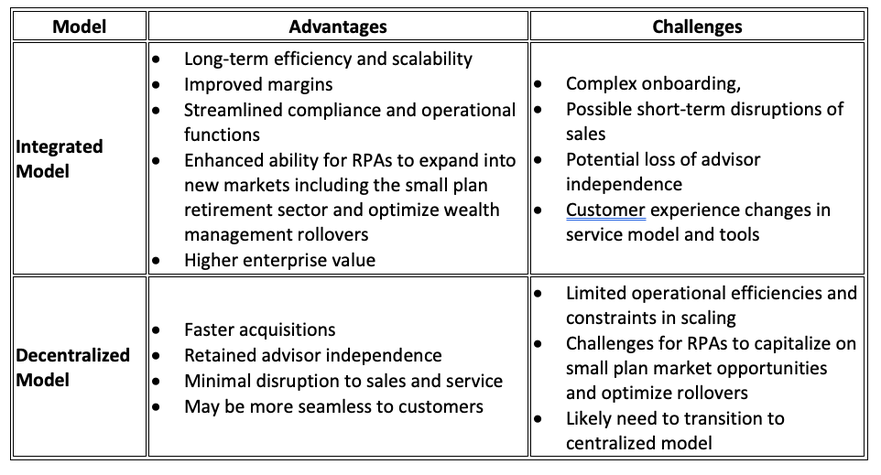The registered investment advisor industry is undergoing a profound transformation, with consolidation becoming an undeniable force reshaping the competitive landscape. Driven by the increasing complexity of compliance, technology demands and client expectations, firms are seeking scale and efficiency through mergers and acquisitions. A significant catalyst behind this wave of consolidation is the growing involvement of private equity firms, which are actively investing in and acquiring RIAs, including retirement plan advisor practices.
As firms navigate this evolving landscape, two primary acquisition models have emerged: a centralized integration structure and an independence-preserving approach. Each model presents unique opportunities and challenges, influencing a firm’s ability to scale, optimize operations and sustain long-term growth. Evaluating these models is crucial for firms aiming to remain competitive in an industry that increasingly rewards scale and efficiency. It is especially true for RPAs focused on the retirement industry opportunity
Two General Models of Acquisition
Centralized Structure Integration
The centralized integration model consolidates acquired firms into a unified operational framework, often seen in independent or PE-backed transactions. This approach focuses on achieving long-term scalability and cost efficiencies by aligning critical operational functions such as platforms, data systems, provider relationships, product offerings, compliance policies and legal structures.
The benefits of this model are evident in its ability to drive cost reduction, streamline reporting and optimize resource allocation. By unifying back-office operations and aligning technology systems, firms can enhance compliance efficiencies and significantly expand into new markets. For RPA firms, this includes the increasingly important small plan retirement market, where scalability and operational efficiencies can create significant growth potential. Additionally, optimizing the rollover opportunity for wealth management services presents a major avenue for revenue generation, as firms can better transition retirement assets into managed investment portfolios.
However, the transition to a centralized model is not without challenges. Onboarding complexities, operational disruptions, customer experience changes and advisor resistance to relinquishing independence can create short-term hurdles. Despite these initial challenges, firms adopting this model often find themselves better positioned for long-term growth and profitability.
Independence-Preserving Model
Alternatively, the independence-preserving model prioritizes minimal disruption to an acquired firm’s operations. Under this structure, firms retain their existing CRM systems, investment platforms, and compliance and legal frameworks.
This approach particularly appeals to advisors who value autonomy and prefer maintaining their established client relationships and revenue-generation models. By allowing firms to continue operating as they did pre-acquisition, this model facilitates faster transactions and reduces integration risks. It is also an attractive strategy for PE firms focused on short-term revenue generation and advisor retention.
However, while this model offers short-term advantages, its long-term viability remains questioned. Firms operating under decentralized structures often struggle to achieve the operational efficiencies required to compete at scale. Limited synergies and inefficiencies in compliance and reporting can hinder their ability to expand into broader markets. It is particularly problematic for RPAs and the small plan retirement sector, where scale is necessary for profitability. Furthermore, without centralized infrastructure, firms with RPAs may struggle to optimize wealth management rollover opportunities, limiting their ability to capture additional revenue streams from transitioning retirement assets into managed portfolios. As a result, many firms following this model eventually transition to a more centralized structure to unlock the full benefits of consolidation.
Weighing the Benefits and Challenges

Key Takeaways
As consolidation reshapes the RIA and RPA industry, firms must carefully evaluate the trade-offs between autonomy, integration, and timing. While a decentralized model offers immediate stability, the long-term advantages of a centralized structure cannot be ignored. Firms that successfully balance short-term sales retention with long-term operational efficiencies will be best positioned for sustainable growth and market expansion.
For firms with RPAs considering their next move, the time to assess their model is now. The industry’s rapid evolution presents both risks and unprecedented opportunities—those who act decisively will optimize the lucrative retirement and rollover opportunity.










